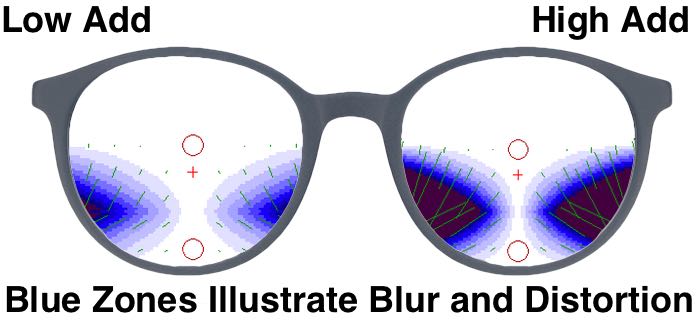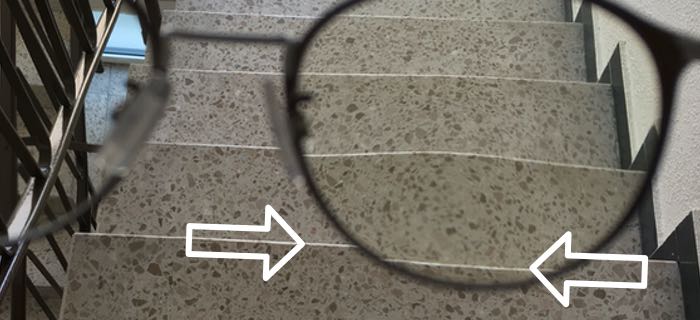In this article, you will learn about how progressive lenses can cause vertigo and how it can be reduced. If you still experience vertigo with progressive lenses I will present you alternative options.
Yes, progressive lenses can cause vertigo. If the wearer is sensitive to the changes in the visual perception that goes along with progressive lenses.
There are two major points that could lead to vertigo with progressives. Those are:
- Askew distortions in the lower periphery
- Deviation of the picture (prismatic changes)
Both points are unavoidable when it comes to progressive lenses. But depending on your prescription and the chosen lens design they can be a little tweaked to your advantage.
Askew Distortion and How to Avoid It in Progressive Lenses
Manufacturers of progressive lenses are constantly working on them to reduce distortions and blur in the lower periphery of the lenses but those drawbacks are still there. Also in high-end lenses. No matter what the marketing says. When I talk about askew distortion I talk about a straight line you perceive as bent in the lower half of the lens.

Now think about this you could see a difference in your visual perception in the upper half of the lens compared to the lower half of the lens. What you receive is the whole picture that gets combined by your brain. Of course, this can be a problem. In most cases, people experience vertigo with progressive lenses when they move around.
Because the lower half of the lenses leads to another movement of the picture as the upper half does. This is definitely confusing. In most cases, the brain deals with the new perception, and normality sets in. The askew distortions then become unobservable.
But in seldom cases, the wearer can not adapt to the new perception. Than the visual experience produced by the progressives becomes stress.
This askew distortion is mostly driven by two factors. First the needed reading power. The more lens power you need in the lower half of the lenses to be able to read the more askew your perception probably will be in the lower periphery.

And the smaller your clear field of view gets. This is true for every progressive lens out there. No matter the manufacturer. Second, if you buy a short progressive lens design you will also get more distortions in the periphery. The rule is the shorter the chosen lens design is the more distortions you will experience and the smaller your clear field of view will be.
When we talk about short lens designs in most cases we talk about 12-14mm from the point you are looking straight ahead into the distance to full reading support wehn you look down. In comparison to that a long lens design is around 18mm long.
So if you would like to have a less askew perception and a bigger field of view you would have to go with the longest progressive lens design that is suitable for you in combination with the lowest amount of reading power.
The reading power is also known as Add value. +2.00 is high and usually, people in their 60s need this value. At 45 years old people need in most cases an Add value of +1,00 diopters. In the years in between this value increases over time. However, the Add value can vastly change depending on the ability to adapt to near distances from person to person.
Deviation of the Picture (Prismatic Changes)
In the first part of this article, we talked about the change in shapes which is definetly a problem with progressive lenses and could lead to vertigo temporarily only for the time the glasses are worn. But here in the second part, we talk about side effects you do not here a lot about.
When you need two different lens powers in your left and your right eye the objects you see are perceived a little higher or lower in one eye compared to the other.

Depending on your needed prescription this can happen as you perform eye movements up and down or from side to side. If you think about how progressive lenses are built you are forced to perform eye movements to be able to reach the zone for full reading support or distance vision.
The higher the imbalance is from your left to your right eye the higher the probability for problems with temporary vertigo. A rule of thumb says problems may arise if your imbalance of lens power in both eyes is bigger than 1,5 diopters. But this is a very vague statement. Depending on how sensitive people are problems can arise way earlier.
In most cases, the wearer of progressives gets used to the imbalance. The eye muscles adjust to the new conditions and the woozy feeling goes away. If not you should try a shorter lens design. Because in a short progressive lens design you need to perform fewer eye movements to reach full reading support.
But remember this comes with a tradeoff. You will minimize the side effects of the imbalance of the lens power with the price of a smaller field of view and more distortions in the periphery. In most cases, people are a bit confused about what to do in such a situation. Depending on how high the imbalance is this would my major point to get rid of temporary vertigo if you want to stay with progressives.
Because in the first part your brain will probably adjust after time to the conditions the progressives give you. In the second part with the side effects your eyes muscles would have to flex in an imbalanced way to be able to use the progressives which could lead to an imbalanced posture to compensate for the imbalanced muscle tension.

Which could lead to problems in your neck and shoulder regions. But it should be clear that vertigo or the woozy feeling should just stay as long as you wear progressives and can then be optimized. If the feeling stays even if you are not wearing your progressives you should seek for additional advice by your physician to check for the cause.
What Are the Alternative Options If Progressives Still Produce Vertigo?
- Single Vision Lenses
- Bifocal Lenses
- Contact Lenses
- One Contact lens in combination with progressive glasses
Those alternatives address the different points we mentioned above. So if you actually like the idea of progressive lenses and the biggest problem why you experienced vertigo was the imbalance in lens power the solution would be to add one contact lens.

In such a case you would wear one contact lens on one eye. The purpose of the contact lens is to balance out the needed lens power. This way you would need to have a less powerful progressive lens. The result would be a deviation that is the same for the left and the right eye.
Now the setting changed with the lens and you could perform eye movements without having a Problem. But you would have to wear the contact lens always in combination with your progressive glasses.
If you can not wear progressive lenses because of the askew distortions they produce and you do not mind having a visible line in your lenses you could go with bifocals. They deliver a clear field of view that is as big as the reading segment you choose.
Contact lenses are a good alternative in general if bifocals or progressives produced vertigo. The reason is you have no askew distortions and you can perform unrestricted eye movements. This is great. But of course, this option also has drawbacks.
If you choose to have progressive contact lenses you might experience a loss in visual acuity. That means you will be able to read but the letters might look a little blurry or you could have some shadow effects going on with those progressive contact lenses.
For a lot of people, this is not an option. In such a case you could go with normal contact lenses in combination with reading glasses or computer glasses.
And of course you could go with a pair of glasses for distance vision and a pair for reading. However, in some cases this could still lead to vertigo because of imbalanced lens power. But the likelihood is pretty much nonexistend.
Those are the options you have when you experience vertigo with your progressive lenses. I hope you found the information you were looking for.
I wish you a great day.
